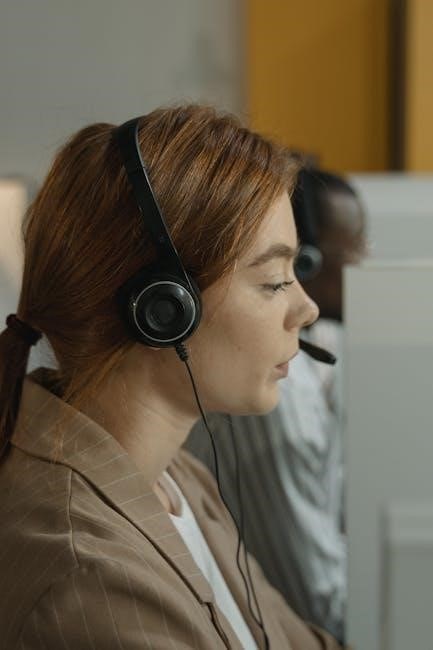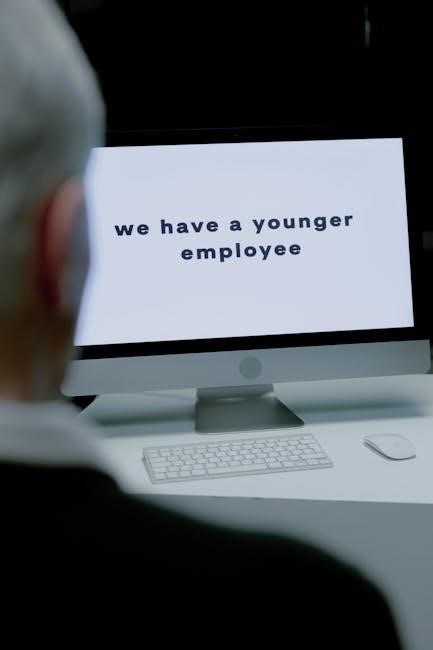The Texas Transition and Employment Guide is a comprehensive resource designed to help students with disabilities plan for adult life, including education, employment, and community support․
1․1 Overview of the Guide
The Texas Transition and Employment Guide provides a detailed framework to assist students with disabilities in transitioning from school to adult life․ It covers essential topics such as transition services, employment opportunities, Social Security programs, and community support․ The guide is structured to address the needs of students, parents, educators, and service providers, offering practical steps and resources․ It emphasizes the importance of early planning and collaboration among stakeholders․ Key sections include transition assessments, goal setting, and workplace accommodations․ The guide also explores post-secondary education options and self-advocacy strategies․ By focusing on individualized plans and real-world applications, it aims to empower students with disabilities to achieve their post-school goals successfully․
1․2 Importance of Transition Planning for Students with Disabilities
Transition planning is critical for students with disabilities to ensure a smooth shift from school to adult life․ It helps students achieve independence, self-advocacy, and long-term success․ Effective planning addresses education, employment, and community living, tailoring strategies to individual needs․ Early preparation reduces dependency on others and enhances confidence․ It also connects students to resources and services, fostering a supportive network․ Transition planning empowers students to explore career options, develop life skills, and understand their rights․ By focusing on personal goals and aspirations, it creates a pathway to meaningful employment and community engagement, improving overall quality of life and future opportunities․
1․3 Key Stakeholders Involved in the Transition Process
The transition process involves collaboration among key stakeholders, including students, parents, educators, and service providers․ Students play a central role in shaping their own goals and outcomes․ Parents provide emotional support and advocacy, ensuring their child’s needs are met․ Educators, such as special education teachers and transition specialists, develop and implement personalized plans․ Service providers, including vocational rehabilitation counselors and disability support agencies, offer resources and connections to employment and community services․ Together, these stakeholders work to create a coordinated and student-centered approach, ensuring a successful transition to adult life, education, and employment․ Their collective efforts foster independence and empower students to achieve their full potential․

Transition Services and Supports
Transition services and supports focus on helping students with disabilities achieve post-school goals through student-centered planning, IEP development, assessments, and goal setting to ensure successful outcomes․
2․1 Student-Centered Transition Planning
Student-centered transition planning is a collaborative process that focuses on the individual needs, preferences, and goals of students with disabilities․ This approach ensures that transition services are tailored to the student’s unique aspirations, whether they involve post-secondary education, employment, or independent living․ The process involves active participation from the student, their family, educators, and other support agencies․ By prioritizing the student’s voice, this method fosters self-advocacy and empowerment, enabling them to take ownership of their future․ The goal is to create a personalized plan that aligns resources and services with the student’s strengths, interests, and long-term objectives, ensuring a smooth and successful transition to adult life․
2․2 Role of the Individualized Education Program (IEP) in Transition
The Individualized Education Program (IEP) plays a central role in transition planning by outlining a student’s goals, services, and supports tailored to their unique needs․ Transition planning within the IEP begins by age 14, focusing on post-school goals related to education, employment, and independent living․ The IEP team, including the student, family, educators, and agencies, collaborates to identify strengths, needs, and aspirations․ Key components include present levels of performance, annual goals, and transition services․ The IEP ensures alignment between academic and functional skills, preparing students for life beyond high school․ It also connects students to resources and services, fostering a seamless transition to adult life․
2․3 Transition Assessments and Goal Setting
Transition assessments are critical tools used to identify a student’s strengths, needs, and interests, guiding the development of meaningful post-school goals․ These assessments, conducted by the IEP team, may include interest inventories, skills evaluations, and functional assessments․ The results inform goal setting, ensuring alignment with the student’s aspirations and realistic outcomes․ Goals are tailored to prepare students for education, employment, and independent living, with measurable objectives․ Regular progress monitoring ensures adjustments are made as needed․ Transition assessments and goal setting empower students to take an active role in their future, fostering a personalized and outcomes-driven transition plan․ This process is essential for ensuring a successful transition to adult life․

Employment Services and Opportunities
This section explores employment services, including supported employment, customized strategies, and workplace accommodations under the ADA, helping students with disabilities achieve successful career outcomes and independence․

3․1 Supported Employment: Definitions and Benefits
Supported employment is a model enabling individuals with disabilities to work in integrated settings alongside non-disabled peers․ It provides ongoing support, such as job coaches and assistive technologies, to ensure success․ Benefits include increased independence, improved self-esteem, and access to competitive wages․ This approach fosters skills development and long-term career growth․ Employers also gain by diversifying their workforce and improving retention rates․ The Texas Transition and Employment Guide emphasizes supported employment as a key strategy for empowering students with disabilities to achieve fulfilling careers and financial stability․
3․2 Customized Employment Strategies for Students with Disabilities
Customized employment strategies tailor job roles to match the skills, interests, and strengths of students with disabilities․ These strategies involve collaboration between students, educators, and employers to create personalized employment plans․ Techniques include job exploration, workplace assessments, and task customization to ensure a good fit․ Benefits include increased job satisfaction, enhanced productivity for employers, and opportunities for career advancement․ The Texas Transition and Employment Guide highlights these strategies as effective ways to bridge the gap between education and employment, fostering inclusive and supportive work environments․ By focusing on individual needs, customized employment empowers students to achieve their career goals and thrive in the workforce․
3․3 Workplace Accommodations and the ADA
Workplace accommodations under the Americans with Disabilities Act (ADA) ensure individuals with disabilities have equal access to employment opportunities․ Employers are required to provide reasonable accommodations, such as adaptive equipment, flexible schedules, or assistive technologies, to enable employees to perform essential job functions․ The ADA prohibits discrimination and promotes inclusive work environments․ The Texas Transition and Employment Guide emphasizes the importance of understanding these rights and responsibilities, helping students with disabilities advocate for necessary accommodations․ By complying with ADA standards, employers create accessible and supportive workplaces, fostering productivity and employee satisfaction․ This section highlights how workplace accommodations empower individuals with disabilities to thrive in their careers․

Social Security Programs and Benefits
This section explores Social Security programs, including Supplemental Security Income (SSI) and Social Security Disability Insurance (SSDI), providing financial support and employment incentives for individuals with disabilities․
4․1 Understanding Supplemental Security Income (SSI)
Supplemental Security Income (SSI) is a federal program providing financial assistance to individuals with disabilities, blindness, or age (65 or older)․ Eligibility is based on disability, income, and resource limits․ SSI helps cover basic needs like food, shelter, and clothing․ It also offers Medicaid coverage, crucial for healthcare access․ Recipients must meet strict income thresholds, with certain exclusions for work-related expenses․ SSI encourages employment by allowing individuals to work while receiving benefits, with deductions for earned income․ This program is vital for ensuring financial stability and independence for people with disabilities, aligning with the Texas Transition and Employment Guide’s goals of fostering self-sufficiency and inclusion․
4․2 Social Security Disability Insurance (SSDI) and Its Implications
Social Security Disability Insurance (SSDI) provides benefits to individuals with disabilities who have worked and paid Social Security taxes․ Eligibility is based on a proven work history and a medical condition that prevents substantial gainful employment․ SSDI benefits are calculated using earnings history and may include Medicare coverage after a two-year waiting period․ Recipients can attempt work through a trial work period without losing benefits․ However, earnings above certain thresholds may affect benefit eligibility․ SSDI is distinct from SSI, as it is funded through FICA contributions rather than general taxes․ Understanding SSDI is crucial for individuals with disabilities to navigate employment and financial planning while maintaining necessary support․
4․3 The Ticket to Work Program: Empowering Individuals with Disabilities
The Ticket to Work Program is a federal initiative designed to help individuals with disabilities achieve employment and financial independence․ Administered by the Social Security Administration (SSA), the program provides access to vocational rehabilitation, job training, and employment services․ Eligible participants receive a “ticket” to assign to an approved employment network (EN) or state vocational rehabilitation (VR) agency․ These providers assist with job placement, career counseling, and workplace accommodations․ The program aims to reduce dependence on disability benefits by fostering self-sufficiency․ Participants can work while maintaining Medicare coverage and gradually transition off cash benefits as their earnings increase․ This program empowers individuals with disabilities to explore career opportunities and achieve long-term employment goals․

Community and Long-Term Services and Support
Community and long-term services provide essential support for individuals with disabilities, enabling independence and participation in society․ These services include home care, transportation, and independent living programs․
5․1 Home and Community-Based Services (HCBS)
Home and Community-Based Services (HCBS) provide personalized support for individuals with disabilities to live independently in their communities․ These services include assistance with daily living tasks, employment support, and access to social activities․ HCBS programs are designed to meet the unique needs of each individual, ensuring they can thrive in their homes and communities․ By focusing on independence and integration, HCBS helps individuals with disabilities lead fulfilling lives while maintaining connections to family, friends, and community resources․ These services are essential for long-term success and are often tailored to address specific goals and preferences․
5․2 Independent Living Centers and Their Role in Transition
Independent Living Centers (ILCs) play a vital role in supporting individuals with disabilities during their transition to adult life․ These centers provide personalized services, including peer mentoring, independent living skills training, and advocacy․ ILCs empower individuals to make informed decisions about their lives, focusing on self-determination and community integration․ They also connect individuals with local resources, such as housing, transportation, and employment opportunities․ By fostering independence and confidence, ILCs help individuals with disabilities navigate the transition process effectively, ensuring they can lead fulfilling and self-directed lives within their communities․

Post-Secondary Education and Training
Post-secondary education and training offer opportunities for students with disabilities to explore college options, vocational training, and Career Technical Education (CTE) programs, preparing them for future careers․

6․1 Exploring College Options for Students with Disabilities
Exploring college options is a critical step for students with disabilities transitioning to post-secondary education․ Colleges offer diverse programs tailored to individual needs, ensuring accessibility and inclusion․ Students can pursue degrees in various fields while accessing support services like academic accommodations, counseling, and assistive technologies․ Legal rights under the Americans with Disabilities Act (ADA) and Section 504 of the Rehabilitation Act ensure equal access to higher education․ Campus resources, such as disability services offices, play a vital role in fostering success; Students and families should research colleges with strong support systems, visit campuses, and engage with disability services to make informed decisions about their academic and career paths․
Additionally, many colleges provide inclusive programs and scholarships specifically for students with disabilities, further enhancing their educational experiences and opportunities for growth․
6․2 Vocational Training and Career Technical Education (CTE)
Vocational training and Career Technical Education (CTE) provide students with disabilities the skills needed for specific careers, aligning with the Texas Transition and Employment Guide’s focus on employability and independence․ These programs offer hands-on training, certifications, and practical experience in high-demand fields like healthcare, technology, and trades․ CTE programs are tailored to meet individual needs, ensuring students gain competitive skills for the workforce․ They often include job coaching, mentorship, and assistive technologies to support success․
By collaborating with local industries and educators, CTE programs bridge the gap between education and employment, empowering students with disabilities to pursue fulfilling careers and achieve their long-term goals․

Self-Advocacy and Empowerment
Self-advocacy and empowerment are crucial for students with disabilities to take charge of their lives, make informed decisions, and express their needs confidently․
7․1 Building Self-Advocacy Skills for Transition Success
Building self-advocacy skills is essential for students with disabilities to navigate their transition to adulthood effectively; Self-advocacy involves understanding one’s strengths, needs, and rights, enabling individuals to communicate their goals and preferences clearly․ Students should learn to express their desires for education, employment, and independent living․ Developing these skills fosters confidence and independence, empowering them to take control of their future․ The Texas Transition and Employment Guide provides strategies and resources to help students identify their interests and abilities, set realistic goals, and advocate for accommodations․ By fostering self-advocacy, students can make informed decisions and actively participate in planning their transition, ensuring a smoother path to achieving their aspirations․
7․2 Legal Rights and Responsibilities of Young Adults with Disabilities
Young adults with disabilities have legal rights and responsibilities that are crucial for their independence and success․ Under the Americans with Disabilities Act (ADA) and the Individuals with Disabilities Education Act (IDEA), individuals are entitled to reasonable accommodations in education, employment, and public spaces․ Understanding these rights empowers young adults to advocate for themselves․ The Texas Transition and Employment Guide emphasizes the importance of knowing legal protections and responsibilities, such as informed consent, privacy laws, and the Age of Majority․ This knowledge enables individuals to make informed decisions about their education, employment, and healthcare․ By understanding their legal rights, young adults can navigate adulthood with confidence and self-determination․

Local Resources and Networks
The Texas Transition and Employment Guide connects students with local resources, including the Texas Transition: Student-Centered Transitions Network and regional support systems, to facilitate successful transitions․
8․1 Texas Transition: Student-Centered Transitions Network
The Texas Transition: Student-Centered Transitions Network is a vital resource for students with disabilities, providing guidance and support for post-school success․ It connects students, families, and educators with local resources, services, and training opportunities to ensure a smooth transition into adult life․ The network emphasizes student-centered planning, focusing on individual needs and goals․ It also facilitates collaboration between schools, state agencies, and community organizations to create a cohesive support system․ By promoting awareness and access to transition services, the network empowers students to achieve independence and pursue meaningful employment or further education․ For more information, families can reach out to the network via email at ltspecialservices@txschools․org․
8․2 Regional Support Systems and Community Partnerships
Regional Support Systems and Community Partnerships play a crucial role in the Texas Transition and Employment Guide by connecting students with disabilities to local resources․ These systems collaborate with schools, employers, and community organizations to provide tailored support, ensuring a seamless transition to adult life․ Partnerships often include vocational training, mentorship programs, and employment placements․ By leveraging local networks, these systems address unique regional needs and foster inclusive environments․ They also promote awareness of disability rights and resources, empowering students and families to navigate post-school opportunities confidently․ These partnerships are essential in creating a supportive ecosystem that champions independence and success for students with disabilities․
